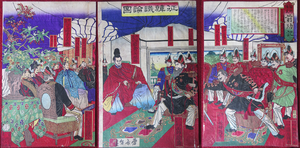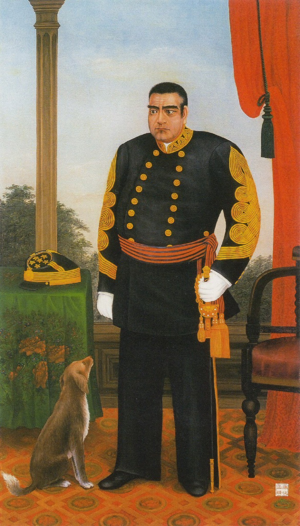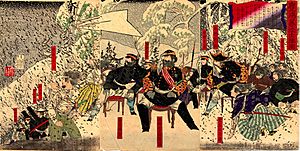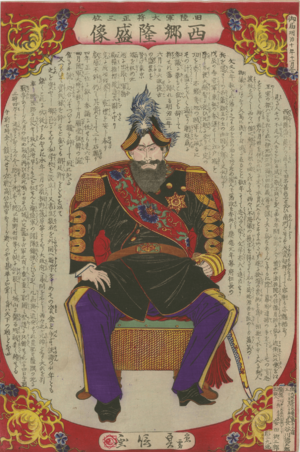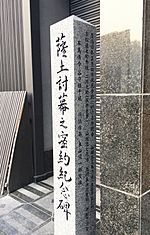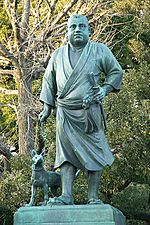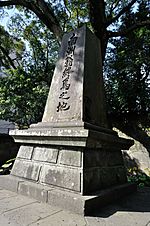Saigō Takamori facts for kids
Quick facts for kids
Saigō Takamori
|
|||||
|---|---|---|---|---|---|
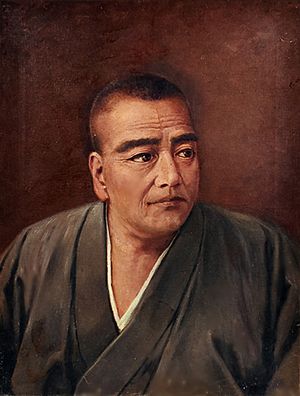
A portrait of Takamori by Ishikawa Shizumasa
|
|||||
| Native name |
西郷 隆盛
|
||||
| Birth name | Saigō Kokichi | ||||
| Other name(s) | Saigō Nanshū Saigō Kichinosuke Kikuchi Gengo |
||||
| Born | January 23, 1828 Kagoshima, Satsuma Domain |
||||
| Died | September 24, 1877 (aged 49) Kagoshima, Empire of Japan |
||||
| Buried |
Nanshu Cemetery, Kagoshima Prefecture, Japan
|
||||
| Allegiance | Satsuma Domain | ||||
| Battles/wars |
|
||||
| Spouse(s) |
Suga Ijuin
(m. 1852; div. 1854)Otoma Kane "Aigana"
(m. 1859–1862)Iwayama Itoko
(m. 1865) |
||||
| Children | Saigō Kikujirō (son) Saigō Kikusō (daughter) Saigō Toratarō (son) Saigō Umajirō (son) Saigō Torizō (son) |
||||
| Relations |
|
||||
| Japanese name | |||||
| Hiragana | さいごう たかもり | ||||
| Katakana | サイゴウ タカモリ | ||||
| Kyūjitai | 西鄕 隆盛 | ||||
| Shinjitai | 西郷 隆盛 | ||||
|
|||||
Saigō Takamori (Takanaga) (西鄕 隆盛 (隆永), January 23, 1828 – September 24, 1877) was a famous Japanese samurai and nobleman. He was one of the most important samurai in Japanese history. He was also one of the three great leaders who helped bring about the Meiji Restoration. This was a big change that brought the Emperor back to power in Japan.
Saigō lived during the late Edo and early Meiji periods. Later in his life, he led a rebellion called the Satsuma Rebellion against the new Meiji government. Many historians see him as a true hero of modern Japanese history.
Contents
Saigō's Early Life
Saigō Takamori was born as Saigō Kokichi (西郷 小吉) on January 23, 1828. He was born in Kagoshima, which was part of the Satsuma Domain. He was the oldest son of Saigō Kichibē, a samurai squire, and his wife Masa.
Saigō had six brothers and sisters. His younger brother, Saigō Jūdō, became a very important military leader. As an adult, Kokichi was given the name Takamori. He also wrote poems using the name Saigō Nanshū (西郷 南洲).
The Meiji Restoration
Japan was ruled by a military leader called the Shogun for many years. But in 1868, the last Shogun, Tokugawa Yoshinobu, gave his power back to the Emperor. This big change was called the Meiji Restoration.
Saigō Takamori was a strong supporter of this change. He believed the Tokugawa family should lose all their lands and special status. His firm beliefs helped cause the Boshin War, a civil war in Japan.
During the Boshin War, Saigō led the Emperor's forces. He commanded them at the Battle of Toba–Fushimi. After that, he led the imperial army to Edo (now Tokyo). There, he accepted the surrender of Edo Castle from Katsu Kaishū, a leader of the Shogun's forces.
Working for the New Government
Even though others like Ōkubo Toshimichi were more active, Saigō played a key role in setting up the new Meiji government. His help was very important for big changes. These changes included getting rid of the old feudal land system (called the abolition of the han system) and creating a new army where ordinary people could join (a conscript army).
In 1871, Saigō was left in charge of the government. This happened while other important leaders were away on a trip to Western countries. This trip was called the Iwakura Mission (1871–73).
Saigō did not always agree with modernizing Japan. He also wasn't sure about opening up trade with Western countries. For example, he famously did not want to build a railway system. He thought the money should be spent on making the military stronger instead.
Debate and Resignation
In 1873, Saigō strongly believed Japan should go to war with Korea. This was part of a discussion known as the Seikanron debate. Korea had refused to accept the new Japanese Emperor as their head of state. They also treated Japanese messengers badly.
Saigō even offered to go to Korea himself. He planned to act in such an insulting way that the Koreans would be forced to kill him. He hoped this would start a war. However, other Japanese leaders disagreed with his plans. They worried about the cost of a war. They also knew Japan was not as strong as Western countries, especially after what they saw during the Iwakura Mission.
Because his ideas were not accepted, Saigō resigned from all his government jobs. He then went back to his hometown of Kagoshima.
The Satsuma Rebellion (1877)
After Saigō returned home, a private military school opened in Kagoshima. It was called the Shi-gakkō. Many loyal samurai who had also left their jobs in Tokyo followed Saigō and joined this school. These unhappy samurai soon gained a lot of power in the Kagoshima government.
The government in Tokyo worried about a rebellion. So, they sent warships to Kagoshima to take weapons from the local arsenal. This action caused open conflict. Tensions were already very high because the government had stopped paying samurai their traditional rice stipends in 1877.
Saigō was very upset by the idea of a revolt. But he was convinced to lead the rebels against the central government.
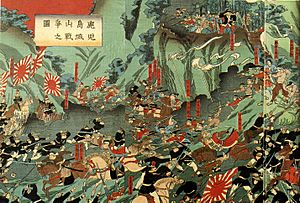
The rebels fought two important battles against the government. These were the Siege of Kumamoto Castle and the Battle of Tabaruzaka. Saigō first thought he could easily take Kumamoto Castle. But he had underestimated the new imperial army. These soldiers were ordinary people, not samurai, but they defended the castle well.
After failing to capture the castle quickly, Saigō began a siege. Eventually, government reinforcements broke through the rebel lines at the Battle of Tabaruzaka. This ended the siege of Kumamoto Castle. Saigō's army retreated, but the imperial forces kept attacking them. Saigō and his last remaining samurai were surrounded and defeated at the Battle of Shiroyama.
Saigō's death marked the end of the Satsuma Rebellion.
Saigō's Death
During the Battle of Shiroyama, Saigō was badly hurt in his hip. How he actually died is not fully known. There are no official reports from people who saw it happen.
Legends About Saigō
Many stories and legends grew about Saigō after his death. Some people believed he had not died at all. They thought he had escaped to Russia or even gone to Mars. There was even a story that his image appeared in a comet in the late 1800s. This was seen as a bad sign for his enemies.
The Japanese people loved Saigō because he showed the true spirit of a traditional samurai. The Meiji government could not stop this affection. So, on February 22, 1889, they officially pardoned him after his death. People admired that he stayed true to his beliefs until he died in 1877.
Artworks and Statues
A famous bronze statue of Saigō stands in Ueno Park, Tokyo. It shows him wearing hunting clothes and standing with his dog. The artist, Takamura Kōun, created it, and it was revealed on December 18, 1898.
A copy of this same statue can be found on Okinoerabujima. This is an island where Saigō was once sent away from Japan.
There is also a Japanese hand fan that shows a scene from "The Battle Near the Citadel of Kumamoto." This fan, which shows Saigō Takamori, is now in a museum in New York.
Saigō's Family
Saigō Takamori had several family members.
Wives and Children
- Ijūin Suga
- Aikana
- Saigō Kikujirō (son): He later became the Mayor of Kyoto City. He studied politics at Johns Hopkins University.
- Saigō Kikusō (daughter)
- Saigō Itoko
- Marquess Saigō Toratarō (son): He became a Colonel in the army. He studied at the Prussian Military Academy.
- Saigō Umajirō (son)
- Saigō Torizō (son)
Siblings
- Marshal-Admiral Marquess Saigō Jūdō (younger brother): He was a very important Navy Minister.
- Saigō Kichijirō (younger brother): He was killed during the Boshin War.
- Saigō Kohei (younger brother): He was killed during the Satsuma Rebellion.
- Ichiki Koto (younger sister)
- Saigō Taka (younger sister)
- Saigō Yasu (younger sister)
Images for kids
See also
 In Spanish: Saigō Takamori para niños
In Spanish: Saigō Takamori para niños
- Seikanron


